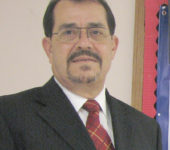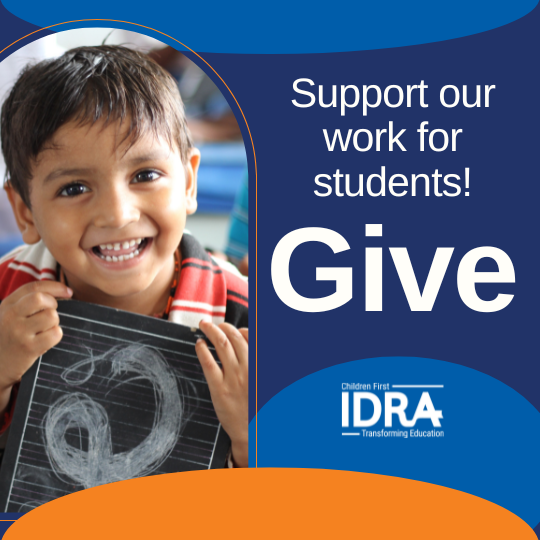• by Rogelio López del Bosque, Ed.D. • IDRA Newsletter • January 1997
 Schoolwide programs focus on the needs of students in high-poverty schools to ensure that every student succeeds. They are built on the understanding that students are most successful when the entire school supports the education of all students. This understanding is supported by a strong research base.
Schoolwide programs focus on the needs of students in high-poverty schools to ensure that every student succeeds. They are built on the understanding that students are most successful when the entire school supports the education of all students. This understanding is supported by a strong research base.
Under Title I of the 1994 reauthorization of the Elementary and Secondary Education Act (ESEA), schools serving 50 percent of students from low-income families can become schoolwide programs to expand the flexibility and quality of the education they offer students. Title I is no longer about pulling out students or using remediation strategies and other temporary approaches attempting to address the special needs of some students. Title I is now about integrating resources, facilities and materials with quality teaching that is cutting-edge and strategically aligned with the educational needs of students on the campus.
Researchers learned during the late 1980s that improving the entire school, rather than targeting the poorest-performing students, improves the education of all students. Schoolwide programs are about getting everyone on campus to commit to supporting instructional programs of higher order thinking skills, accelerated curriculum and effective teaching strategies. The focus is on the students to ensure that everyone succeeds. Thus, successful schoolwide programs do the following:
- identify students’ needs and decide how to meet them;
- engage and expand on students’ natural gifts and talents;
- work together to help every child achieve the same challenging standards;
- design educational programs that are consistent with state and local reform efforts;
- meet the special needs of children who are at risk academically, limited English proficient, migrant or homeless;
- break through traditional funding limitations by combining resources from multiple funding streams to promote children’s learning;
- seek support and guidance from fellow practitioners within the district and across the state who have successfully shifted to using ESEA resources school-wide; and
- evaluate success in terms of increased achievement by students at greatest risk of failing to meet state standards (U.S. Department of Education, 1996).
Even with these guidelines, a recent study of schools in Texas found that there is no magic formula, prescription or miracle program. The study was conducted by the Charles A. Dana Center at the University of Texas at Austin with support from the Texas Education Agency and the STAR Center (a collaboration of the Dana Center, IDRA and RMC Research Corporation), the comprehensive regional assistance center in Texas (1996). The findings revealed more differences than similarities in the instructional programs and approaches of the 26 schools studied. While some schools used whole language teaching approaches, others used phonics. Some programs used cutting-edge instructional technology, while others used none. Some schools used Levin’s “Accelerated Schools Project,” and others used the “Success for All” program from John Hopkins University. “Reading Recovery” approaches were used by some schools, while others were not using any specific program or methodology at all.
Although these schools did not perceive themselves as perfect, they recognized a potential for growth and were committed to seeing ongoing improvement. Each school had an area of strength as well as an area of weakness, yet they had all achieved important and impressive results.
The common characteristics of these schools include the following. Each school:
- Focuses on the academic success of every student;
- Makes no excuses;
- Experiments;
- Is inclusive – Everyone is seen as a part of the solution;
- Has a sense of family;
- Demonstrates collaboration and trust;
- Exhibits a passion for learning and growing.
This detailed study, Successful Texas Schoolwide Programs, can be obtained through the Charles A. Dana Center (512/471-6190).
Shifting to a schoolwide approach gives teachers new opportunities to enrich instruction and accelerate student learning. Their involvement is critical in the reform process. Their expertise can be easily tapped because they know the school much better than anyone else and they know what needs to be changed. This means that teachers must be supported in what they are doing and must be provided with appropriate professional development.
An example of an effective schoolwide approach is IDRA’s Project FLAIR (Focusing on Language and Academic Instructional Renewal). This project is an outgrowth of IDRA’s reading project that has assisted schools as they shift to schoolwide programs and subsequently improve students’ academic success dramatically. Project FLAIR is designed to increase cognitive growth and academic achievement for all students, including language minority students, through an intensive language-across-the-curriculum program. Currently, 13 schools are using Project FLAIR to support their schoolwide approach.
Personnel at each participating campus, with the guidance of an IDRA consultant, analyze and evaluate their instructional program to determine how well it reflects the best practices recommended for culturally and linguistically diverse students. A task force of administrators and teachers develops annual goals and objectives designed to improve language-minority student achievement, and members select a set of instructional strategies for monthly training on their campus.
The first year of the project ends with a day of reflection in which the campus task force members evaluate the success of the project and plan for the second year. They then choose another set of instructional strategies for monthly training and decide how to mentor and train new teachers during the second year. The project’s third year continues to increase the repertoire of instructional strategies available to teachers and expands training to the rest of the teachers on the campus.
This three-year process incorporates all components of an effective schoolwide program. It includes assessment, development of a model based on findings, and development of a mission and a vision statement through the selected people who will carry out the process. The project includes professional development that provides research-based strategies, mentoring and coaching, along with classroom demonstration. Project FLAIR has a comprehensive monitoring system with formative evaluations throughout each year and a formal summative evaluation at the end of each year.
Specifically, Project FLAIR addresses requirements of a schoolwide program through the following eight components:
Comprehensive needs assessment. A comprehensive needs assessment is critical for designing the program, professional development and evaluation. Classroom observations, faculty and staff interviews and workshop evaluations are the primary means of data collection.
Best-practice school reform strategies. Cutting-edge practices based on the latest research provide guidance. Because schoolwide programs require adjustments for many schools, a comprehensive approach is necessary and is an integral part of Project FLAIR.
Highly qualified instructional staff who promote high student achievement. These are the teachers who participate based on their ability to alter curriculum and instruction to accommodate students’ strengths and needs. The assumption is that they, along with the curriculum, will challenge the students academically. Therefore, strategies the teachers will be trained to implement through the project are based on the latest research in the fields of bilingual and English as a second language (ESL) education and language arts education. They foster listening, speaking, reading, and writing skills and can be used for all content areas and with students who are below, on or above grade level. Teachers are taught how to use the strategies, how to modify them for various grade levels and how to assess student progress in mastering their complexities.
Assuming ownership and “buying into” the program is an essential part of the project. Just as all students are to be regarded highly, so should the teachers. They are the link between student learning and teaching to the established high standards. Through the project, they work in teams and learn how to provide the right amount of resources for their students. They also learn about research-based programs that may involve intensive instruction such as use of technology, fostering cultural pride and building student self-concept.
Qualified to involve all members of the school community. Professional development is a high priority. It is most effective when the participants help determine the content. In addition to teachers, professional development should include teacher aides, other school staff members and parents. Teachers expand their knowledge base about schoolwide programs and pedagogy related to achievement of high standards. Parents become empowered and are part of the decision-making process in the project. Parents are seen as an asset in the process. School strategies for attaining and retaining parent involvement are essential. In order for many parents to get involved in their children’s education, they must assume new leadership roles. They must practice making decisions, not simply be told “how to.” They must serve on planning and other policy-making committees. The more informed and involved parents are, the more they tend to get involved in the education of their children.
Teacher participation in making assessment and instructional decisions. The involvement of the teachers in the assessment process is essential. Project FLAIR understands that trust must not be violated, and information gathered through the assessment should be seen in the context of the program design rather than as a negative perception of the school. This can only intensify teachers’ ownership of the mission and the effectiveness of the program.
Intensive assistance to students who experience difficulty mastering state standards. First and foremost should be the imparting of high expectations to all students. It may be necessary to customize services for students with very special needs. Although pull-out programs and remedial approaches should be minimized, supplementary instruction may be the answer in meeting the needs of some students for attaining specific goals.
Evaluation data for decision making. Formative and summative evaluation services are provided by IDRA to all participants. IDRA provides an annual report summarizing the quantitative and qualitative results to the central office and each principal.
Role of the principal in the process. One of the major challenges to implementing a schoolwide program is changing from a “mass audience” approach to one of teaching each child. It is the principal whose leadership and management is key to the success of a schoolwide program. In an attempt to make the transition a little easier, in Project FLAIR, principals work with a planning committee that in turn examines programs that create collaboration.
This model has worked by creating learning environments that promote academic achievement gains by empowering administrators, teachers and students with strategies to improve reading instruction and by building capacity in the school district or campus to initiate and sustain change that has a positive impact. This model works for all campuses, regardless of student population profile or past academic performance level. In IDRA’s Project FLAIR everybody wins – teachers, administrators, students and parents.
School districts and campuses can obtain additional information about IDRA’s Project FLAIR by contacting Dr. Rogelio López del Bosque at 210/684-8180.
No Two Schoolwide Programs are Alike, But the Best Are:
|
| – Pechman, E. and L. Fiester. An Idea Book: Implementing Schoolwide Projects. (Washington, DC: US Department of Education, Planning and Evaluation Service, 1994). |
Resources
Charles A. Dana Center. Successful Texas Schoolwide Programs: Research Study Results. (Austin, Texas: Charles A. Dana Center at the University of Texas at Austin, October 1996).
US Department of Education. Improving America’s Schools: A Newsletter on Issues in School Reform, working document. (Washington, D.C.: US Department of Education, October 1996).
Rogelio López del Bosque, Ed.D. is the coordinator for the IDRA Division of Professional Development. Comments and questions may be sent to him via E-mail at feedback@idra.org.
[©1997, IDRA. This article originally appeared in the January 1997 IDRA Newsletter by the Intercultural Development Research Association. Permission to reproduce this article is granted provided the article is reprinted in its entirety and proper credit is given to IDRA and the author.]



